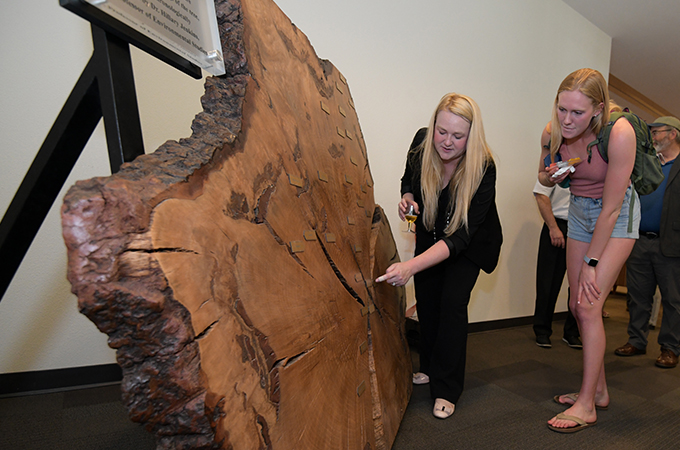On April 24, a group of students, faculty, and staff gathered on the ground floor of the Hunsaker Library for a ceremony to dedicate a new display. The exhibit showcases a large cross-section of an oak tree that stood watch over the University of Redlands Quad from 1925 to 2014. Professor Hillary Jenkins, who spearheaded the nearly four-year effort to preserve and date the slab, spoke at the event. Here are excerpts from her remarks.
I’d like to tell you a bit about the tree rings of this particular oak tree. And being the dedicated scientist that I am, I felt the best way to do this was with a few numbers.
89... is the number of tree rings present on this slab.
26… is the number of times I independently counted these rings to make sure this number was correct
2014 is the year that this tree’s life ended and my preservation project began. [Environmental Studies Professor] Wendy McIntyre first alerted me to the Quercus Agrifolia being cut down in the Quad, and I must give her a tremendous acknowledgment for this and all her help and support since we first began this project.
2 is the number of fungal species (Botryodiplodia and Cytospora) that were killing this tree; evidence of both is present in the visible scarring along the edges of the slab.
2 is the number of chainsaws required to cut a single intact piece this large.
2000 is the number of pounds of raw wood that were forklifted to facilities.
The slab was sanded repeatedly by me, Wendy, and 4 of our work-study students for over a month as it slowly dried.
4 belt sanders, 3 orbital sanders, and 3 small hand-sanders were used smoothing the surface of the slab.
157 is the number of sandpaper belts, discs, and sheets we destroyed during this process.
1 million is the number of trips I made to Home Depot.
Once the slab was sanded smooth, we soaked it in 75 gallons of Pentacryl, a liquid polymer used to seal xylem cell walls and minimize cracking.
1 is the number of kiddie pools I purchased to give the slab this bath.
8 is the number of men it took to flip the slab over so that the Pentacryl would soak evenly; this had to be done every few weeks for several months.
1 is the number of years we soaked and dried the slab before relocating it to Lewis Hall where I continued to sand and polish it. Once polishing was complete, I began counting the rings, identifying false bands, and dating the age of the two hearts where a bifurcation or fork occurs. The slab and its bark were then sealed and shellacked one final time—to stop the clock and freeze the piece in time.
1920 was the decade that this tree put down roots in front of the Redlands Chapel after being transplanted as a sapling.
This tree grew and watched over the university as President Victor Leroy Duke dedicated Memorial Chapel, as the Salzburg Program began, as the Johnston Center was founded, and the Whitehead College was established. This tree quietly grew through the Great Depression and when Neil Armstrong took his first steps on the moon. Even when Atari released Pong, one of the first video arcade games, and the World Wide Web went public, this tree soldiered on.
The rings of this tree carry the rich history of our culture and our university—and will now stand here in the Armacost Library, a monument to the passage of time.
As part of her remarks, Jenkins also acknowledged the many individuals who helped make the project possible, including: McIntyre; Roger Cellini, Melinda Jo Sanchez, and other members of the Facilities Management Department; Deborah Keyes; her “wonderful environmental studies students”; the U of R administration and Development Office; and President Ralph Kuncl. Kuncl also cut the ribbon on the display during the ceremony.






